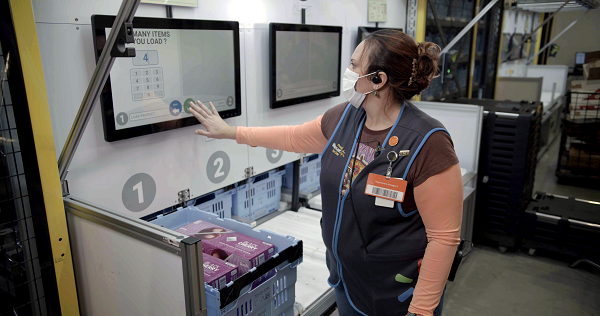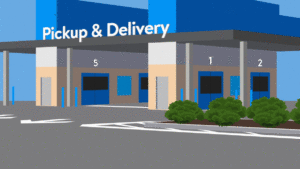Walmart Inc. (No. 3 in the 2020 Digital Commerce 360 Top 1000) is pressing the advantage it gets from operating thousands of stores by adding automation to some locations designed to allow them to fulfill online orders more efficiently.
Walmart, which began testing an automated fulfillment system at a store in Salem, New Hampshire, in late 2019, now says it will roll out similar “local fulfillment centers” (LFCs) at dozens of stores in 2021. An LFC is a compact, modular warehouse built within, or added to, a store. LFCs can store and retrieve fresh and frozen items and thousands of other consumables and general merchandise items such as electronics.

A Walmart associate handling an order in a local fulfillment center.
The LFCs use automated bots to retrieve items from within the fulfillment center, doing part of the work now done by personal shoppers who walk around stores to pick products from shelves. The robotic systems send items to a workstation, where employees assemble the orders for pickup or home delivery. Personal shoppers will continue to retrieve items like produce, meat and seafood and large general merchandise from the sales floor.
“What we want to do is fill as many orders as we can,” said Tom Ward, Walmart’s senior vice president of customer product, told Bloomberg News. “The system allows us to pick orders and dispense them with great speed.”
The Salem store is so, far, the only Walmart store with an LFC. That store uses the Alphabot system from Massachusetts startup Alert Innovation. The system operates inside a 20,000-square-foot warehouse-style space, using autonomous carts to retrieve ambient, refrigerated and frozen items ordered for online grocery. Alphabot’s autonomous bots operate on three axes of motion, making it more flexible than traditional fulfillment centers and warehouses, Walmart says.
“The stores receiving local fulfillment centers are based on customers’ shopping behaviors,” says a Walmart spokeswoman. “These are locations where we see a high number of customers using pickup and delivery services, which gives us the ability to watch and learn and apply that learning as we scale this technology.”
Once orders are collected, the robotic system stores them until customers or delivery drivers pick them up. Walmart says orders can be ready just a few minutes from the time customers buy online.
Walmart plans to test systems from at least three vendors. Each robotic system will have different characteristics, allowing Walmart to understand what works best in different environments, the spokeswoman says.

Walmart says a drive-up local fulfillment center might look like this.
For example, Walmart will outfit some stores with automated pickup points that allow customers and delivery drivers to drive up, scan a code and grab their orders, waiting in a temperature-controlled area outside the store. In some cases, adding LFCs will require Walmart to add square footage to its stores; in others, the LFC will sit inside the existing store footprints, she says.
In addition to Alert Innovation, Walmart will test systems from Atlanta-based Dematic and Fabric, headquartered in New York City.
Walmart says its test of the Alphabot system proved the technology achieved its goal of allowing workers to pick and pack more orders more quickly than relying solely on personal shoppers but did not reveal how much faster. The retailer also says the system’s speed can allow orders to be picked up or delivered within the hour, and one local fulfillment center can fulfill orders for multiple nearby stores. Regardless of which store packs an order, customers would pick up their merchandise from the store they selected online.
The spokeswoman says dozens of LFCs are already under construction but declined to say exactly how many Walmart plans to open in 2021 or after.
Walmart operates more than 4,748 Walmart stores and 599 Sam’s Club warehouses in the U.S.
The video below shows the Alphabot system in action.
Bloomberg News contributed to this report.
Favorite